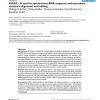188 search results - page 15 / 38 » Improving protein secondary structure prediction using a sim... |
IPPS
2006
IEEE
14 years 1 months ago
2006
IEEE
—Homology modeling requires an accurate alignment between a query sequence and its homologs with known three-dimensional (3D) information. Current structural modeling techniques ...
BMCBI
2006
13 years 7 months ago
2006
Background: In sequence analysis the multiple alignment builds the fundament of all proceeding analyses. Errors in an alignment could strongly influence all succeeding analyses an...
BMCBI
2008
13 years 7 months ago
2008
Background: Prediction of disulfide bridges from protein sequences is useful for characterizing structural and functional properties of proteins. Several methods based on differen...
JCB
2006
13 years 7 months ago
2006
Protein fold recognition is an important step towards understanding protein three-dimensional structures and their functions. A conditional graphical model, i.e., segmentation con...
BMCBI
2008
13 years 7 months ago
2008
Background: Most gene finders score candidate gene models with state-based methods, typically HMMs, by combining local properties (coding potential, splice donor and acceptor patt...

